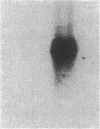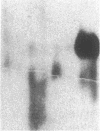Abstract
The human growth hormone-variant (hGH-V) gene is one of five highly similar growth hormone-related genes clustered on the short arm of chromosome 17. Although the pattern of expression of the adjacent normal growth hormone (hGH-N) and chorionic somatomammotropin (hCS) genes in this cluster are well characterized, the expression of the hGH-V gene remains to be defined. In previous studies, we have demonstrated that the hGH-V gene is transcribed in the term placenta and expressed as two alternatively spliced mRNAs: one is predicted to encode a 22-kD hormone (hGH-V), the other retains intron 4 in its sequence resulting in the predicted synthesis of a novel 26-kD hGH-V-related protein (hGH-V2). In the present report, we document the expression of both of these hGH-V mRNA species in the villi of the term placenta, demonstrate an increase in their concentrations during gestation, and directly sublocalize hGH-V gene expression to the syncytiotrophoblastic epithelium of the term placenta by in situ cDNA-mRNA histohybridization. The demonstrated similarity in the developmental and tissue-specific expression of the hGH-V gene with that of the related hCS gene suggests that these two genes may share common regulatory elements.
Full text
PDF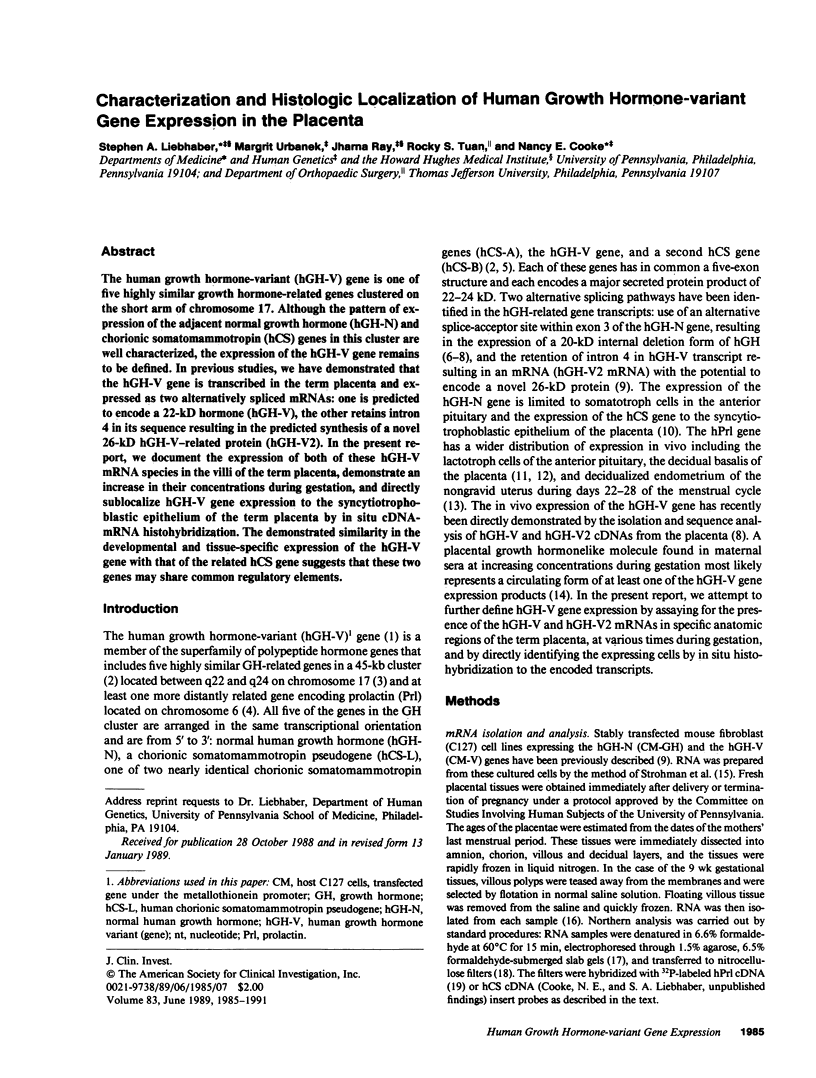
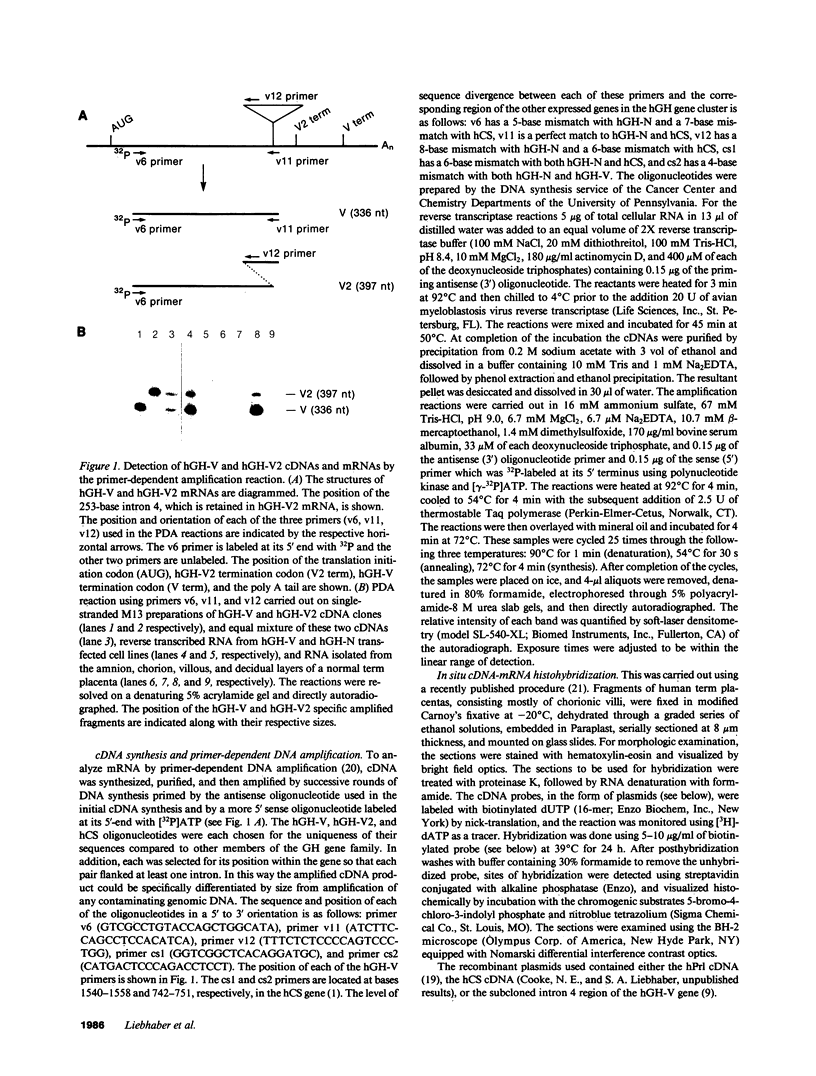
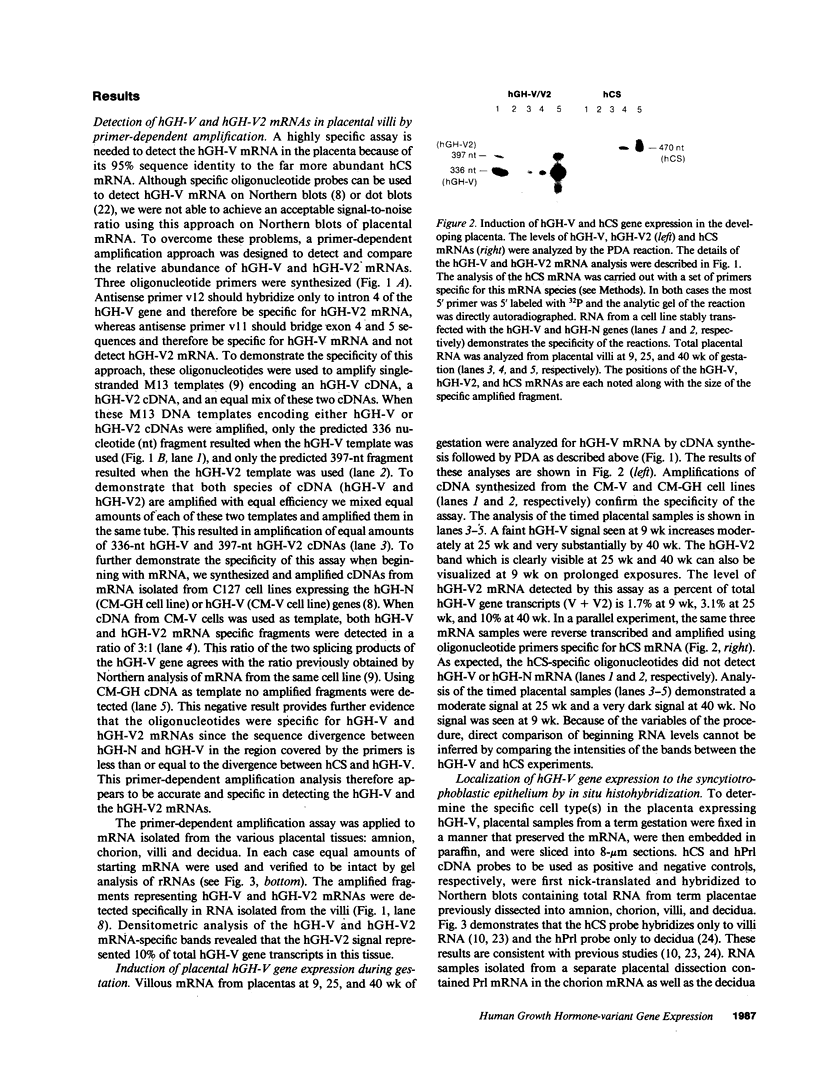
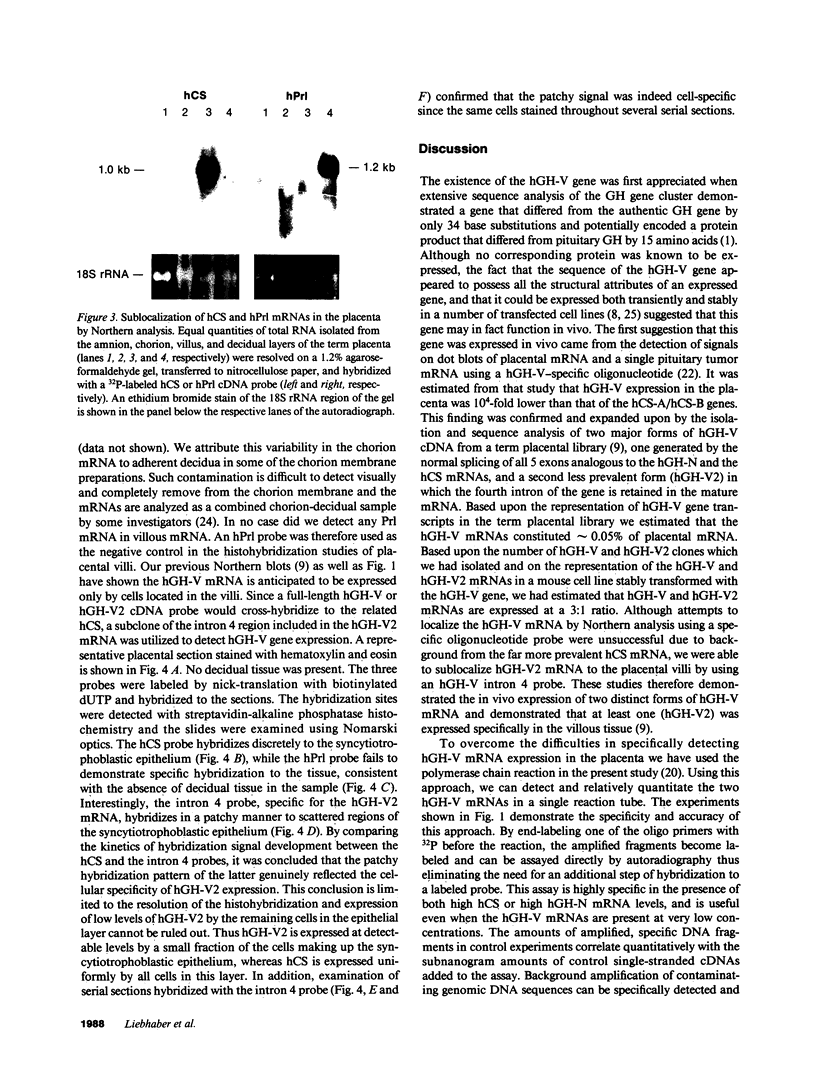
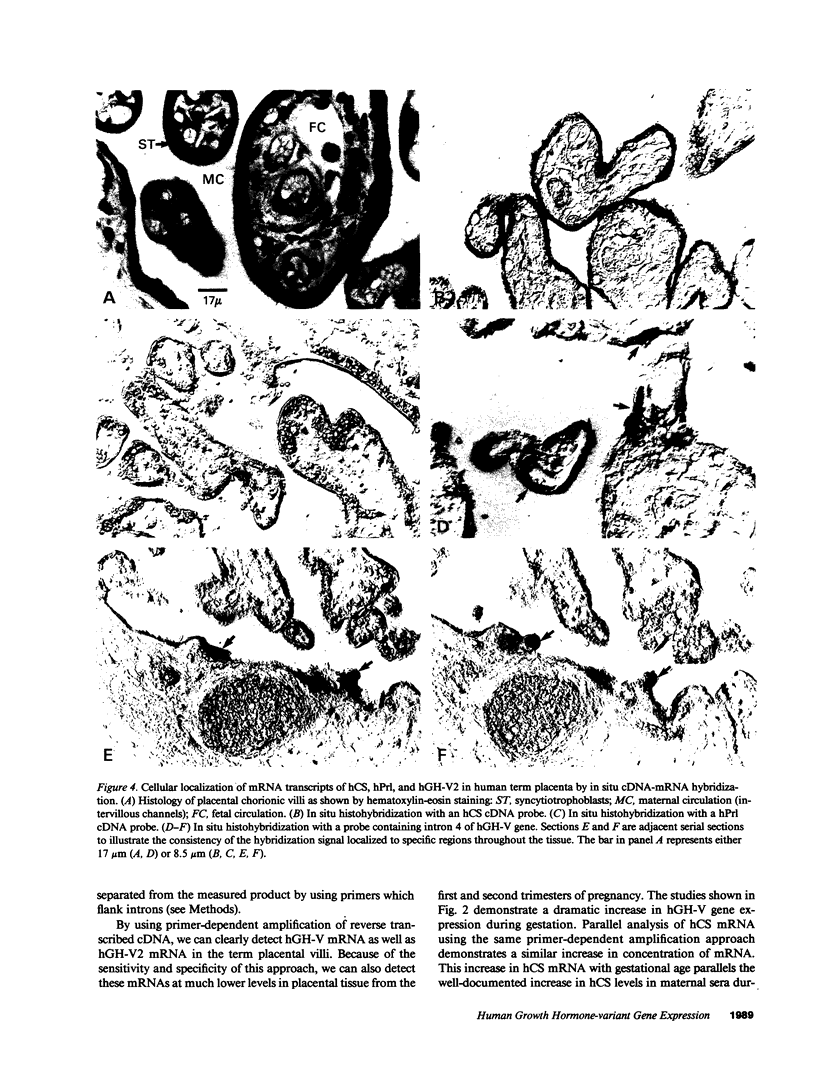

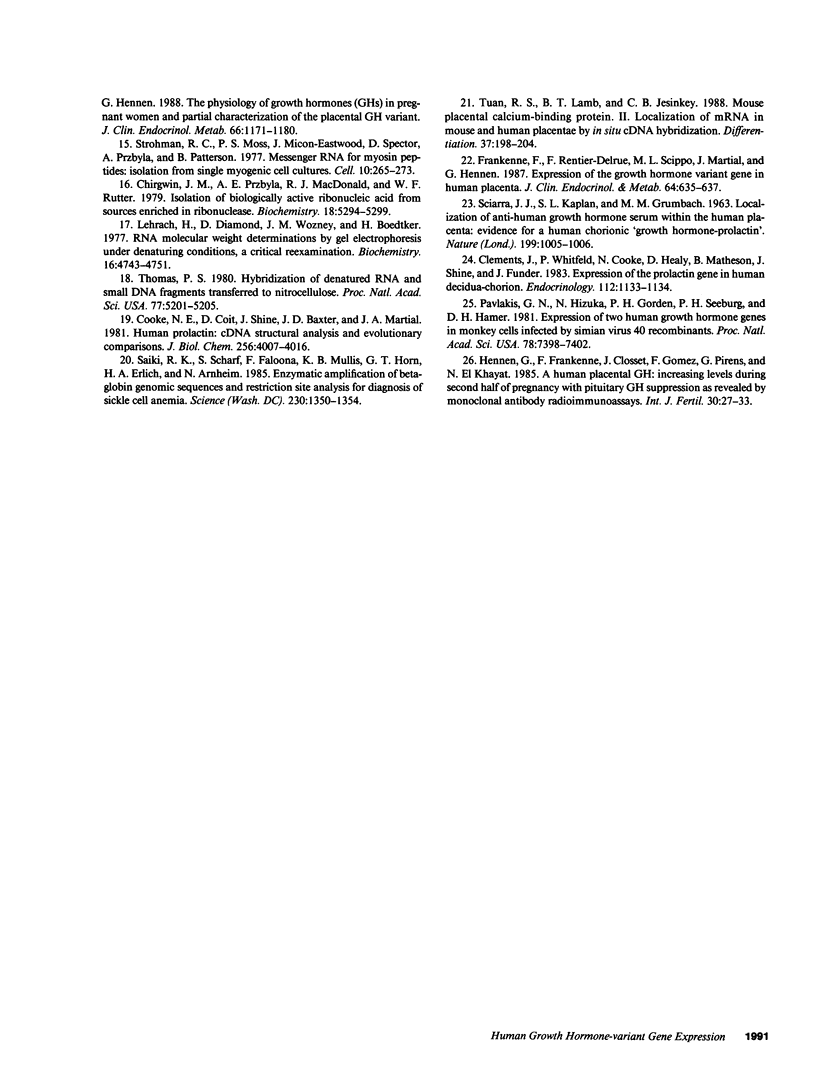
Images in this article
Selected References
These references are in PubMed. This may not be the complete list of references from this article.
- Barsh G. S., Seeburg P. H., Gelinas R. E. The human growth hormone gene family: structure and evolution of the chromosomal locus. Nucleic Acids Res. 1983 Jun 25;11(12):3939–3958. doi: 10.1093/nar/11.12.3939. [DOI] [PMC free article] [PubMed] [Google Scholar]
- Chirgwin J. M., Przybyla A. E., MacDonald R. J., Rutter W. J. Isolation of biologically active ribonucleic acid from sources enriched in ribonuclease. Biochemistry. 1979 Nov 27;18(24):5294–5299. doi: 10.1021/bi00591a005. [DOI] [PubMed] [Google Scholar]
- Clements J., Whitfeld P., Cooke N., Healy D., Matheson B., Shine J., Funder J. Expression of the prolactin gene in human decidua-chorion. Endocrinology. 1983 Mar;112(3):1133–1134. doi: 10.1210/endo-112-3-1133. [DOI] [PubMed] [Google Scholar]
- Cooke N. E., Coit D., Shine J., Baxter J. D., Martial J. A. Human prolactin. cDNA structural analysis and evolutionary comparisons. J Biol Chem. 1981 Apr 25;256(8):4007–4016. [PubMed] [Google Scholar]
- Cooke N. E., Ray J., Emery J. G., Liebhaber S. A. Two distinct species of human growth hormone-variant mRNA in the human placenta predict the expression of novel growth hormone proteins. J Biol Chem. 1988 Jun 25;263(18):9001–9006. [PubMed] [Google Scholar]
- Cooke N. E., Ray J., Watson M. A., Estes P. A., Kuo B. A., Liebhaber S. A. Human growth hormone gene and the highly homologous growth hormone variant gene display different splicing patterns. J Clin Invest. 1988 Jul;82(1):270–275. doi: 10.1172/JCI113582. [DOI] [PMC free article] [PubMed] [Google Scholar]
- DeNoto F. M., Moore D. D., Goodman H. M. Human growth hormone DNA sequence and mRNA structure: possible alternative splicing. Nucleic Acids Res. 1981 Aug 11;9(15):3719–3730. doi: 10.1093/nar/9.15.3719. [DOI] [PMC free article] [PubMed] [Google Scholar]
- Frankenne F., Closset J., Gomez F., Scippo M. L., Smal J., Hennen G. The physiology of growth hormones (GHs) in pregnant women and partial characterization of the placental GH variant. J Clin Endocrinol Metab. 1988 Jun;66(6):1171–1180. doi: 10.1210/jcem-66-6-1171. [DOI] [PubMed] [Google Scholar]
- Frankenne F., Rentier-Delrue F., Scippo M. L., Martial J., Hennen G. Expression of the growth hormone variant gene in human placenta. J Clin Endocrinol Metab. 1987 Mar;64(3):635–637. doi: 10.1210/jcem-64-3-635. [DOI] [PubMed] [Google Scholar]
- George D. L., Phillips J. A., 3rd, Francke U., Seeburg P. H. The genes for growth hormone and chorionic somatomammotropin are on the long arm of human chromosome 17 in region q21 to qter. Hum Genet. 1981;57(2):138–141. doi: 10.1007/BF00282009. [DOI] [PubMed] [Google Scholar]
- Golander A., Hurley T., Barrett J., Hizi A., Handwerger S. Prolactin synthesis by human chorion-decidual tissue: a possible source of prolactin in the amniotic fluid. Science. 1978 Oct 20;202(4365):311–313. doi: 10.1126/science.694535. [DOI] [PubMed] [Google Scholar]
- Hennen G., Frankenne F., Closset J., Gomez F., Pirens G., el Khayat N. A human placental GH: increasing levels during second half of pregnancy with pituitary GH suppression as revealed by monoclonal antibody radioimmunoassays. Int J Fertil. 1985;30(2):27–33. [PubMed] [Google Scholar]
- Hirt H., Kimelman J., Birnbaum M. J., Chen E. Y., Seeburg P. H., Eberhardt N. L., Barta A. The human growth hormone gene locus: structure, evolution, and allelic variations. DNA. 1987 Feb;6(1):59–70. doi: 10.1089/dna.1987.6.59. [DOI] [PubMed] [Google Scholar]
- Lehrach H., Diamond D., Wozney J. M., Boedtker H. RNA molecular weight determinations by gel electrophoresis under denaturing conditions, a critical reexamination. Biochemistry. 1977 Oct 18;16(21):4743–4751. doi: 10.1021/bi00640a033. [DOI] [PubMed] [Google Scholar]
- Lewis U. J., Bonewald L. F., Lewis L. J. The 20,000-dalton variant of human growth hormone: location of the amino acid deletions. Biochem Biophys Res Commun. 1980 Jan 29;92(2):511–516. doi: 10.1016/0006-291x(80)90363-0. [DOI] [PubMed] [Google Scholar]
- Maslar I. A., Riddick D. H. Prolactin production by human endometrium during the normal menstrual cycle. Am J Obstet Gynecol. 1979 Nov 15;135(6):751–754. doi: 10.1016/0002-9378(79)90386-7. [DOI] [PubMed] [Google Scholar]
- McWilliams D., Boime I. Cytological localization of placental lactogen messenger ribonucleic acid in syncytiotrophoblast layers of human placenta. Endocrinology. 1980 Sep;107(3):761–765. doi: 10.1210/endo-107-3-761. [DOI] [PubMed] [Google Scholar]
- Owerbach D., Rutter W. J., Cooke N. E., Martial J. A., Shows T. B. The prolactin gene is located on chromosome 6 in humans. Science. 1981 May 15;212(4496):815–816. doi: 10.1126/science.7221563. [DOI] [PubMed] [Google Scholar]
- Pavlakis G. N., Hizuka N., Gorden P., Seeburg P., Hamer D. H. Expression of two human growth hormone genes in monkey cells infected by simian virus 40 recombinants. Proc Natl Acad Sci U S A. 1981 Dec;78(12):7398–7402. doi: 10.1073/pnas.78.12.7398. [DOI] [PMC free article] [PubMed] [Google Scholar]
- Riddick D. H., Luciano A. A., Kusmik W. F., Maslar I. A. De novo synthesis of prolactin by human decidua. Life Sci. 1978 Nov 9;23(19):1913–1921. doi: 10.1016/0024-3205(78)90557-x. [DOI] [PubMed] [Google Scholar]
- SCIARRA J. J., KAPLAN S. L., GRUMBACH M. M. LOCALIZATION OF ANTI-HUMAN GROWTH HORMONE SERUM WITHIN THE HUMAN PLACENTA: EVIDENCE FOR A HUMAN CHORIONIC 'GROWTH HORMONE-PROLACTIN'. Nature. 1963 Sep 7;199:1005–1006. doi: 10.1038/1991005a0. [DOI] [PubMed] [Google Scholar]
- Saiki R. K., Scharf S., Faloona F., Mullis K. B., Horn G. T., Erlich H. A., Arnheim N. Enzymatic amplification of beta-globin genomic sequences and restriction site analysis for diagnosis of sickle cell anemia. Science. 1985 Dec 20;230(4732):1350–1354. doi: 10.1126/science.2999980. [DOI] [PubMed] [Google Scholar]
- Seeburg P. H. The human growth hormone gene family: nucleotide sequences show recent divergence and predict a new polypeptide hormone. DNA. 1982;1(3):239–249. doi: 10.1089/dna.1.1982.1.239. [DOI] [PubMed] [Google Scholar]
- Strohman R. C., Moss P. S., Micou-Eastwood J., Spector D., Przybyla A., Paterson B. Messenger RNA for myosin polypeptides: isolation from single myogenic cell cultures. Cell. 1977 Feb;10(2):265–273. doi: 10.1016/0092-8674(77)90220-3. [DOI] [PubMed] [Google Scholar]
- Thomas P. S. Hybridization of denatured RNA and small DNA fragments transferred to nitrocellulose. Proc Natl Acad Sci U S A. 1980 Sep;77(9):5201–5205. doi: 10.1073/pnas.77.9.5201. [DOI] [PMC free article] [PubMed] [Google Scholar]
- Tuan R. S., Lamb B. T., Jesinkey C. B. Mouse placental 57-kDa calcium-binding protein: II. Localization of mRNA in mouse and human placentae by in situ cDNA hybridization. Differentiation. 1988 May;37(3):198–204. doi: 10.1111/j.1432-0436.1988.tb00722.x. [DOI] [PubMed] [Google Scholar]






